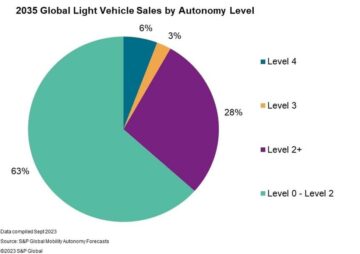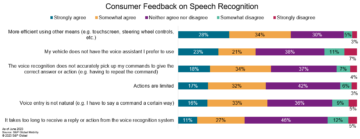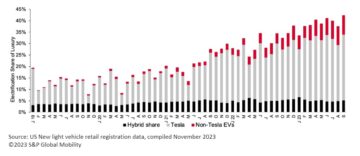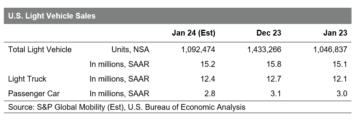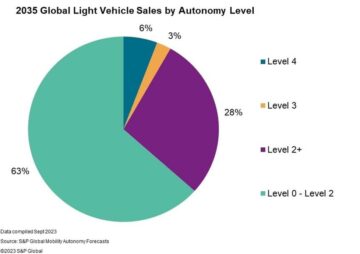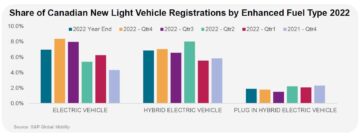Cars have been the stars of video games since the
beginning. Now video games are becoming a star attraction in cars.
Eyeing the broader social impact of technologies such as high-speed
connectivity and high-definition screens, and the trend towards
semi-autonomous driving and shared mobility, automakers are
building their next-generation vehicles with gaming as a core part
of the in-car user experience.
Why are automakers so upbeat about in-car gaming? A recent
industry report suggests the global gaming industry is poised to
maintain its recent rapid growth and is on track to reach $321
billion by 2026. And then there’s this: There are about twice as
many gamers worldwide as there are vehicles on the road. For
automakers, this translates into a lucrative opportunity that
readily aligns with their focus on generating recurring
subscription-based revenue streams.
Robust low-latency 5G networks allow gamers to connect
internet-enabled cars to digital game stores from anywhere. Cloud
gaming platforms are allowing users to enjoy high-quality, lag-free
experiences without the need for huge and expensive hard drives.
With compatible infotainment systems and powerful graphics
processing units (GPUs), high-caliber 3D gaming engines are
rendering in-car gaming experiences at par with home gaming
consoles.
While games are already being played in many vehicles (mostly
Tesla) and money is being made mostly at the distribution level
(subscription packages from Holoride are a proof), the in-car
gaming market will remain nascent in the short term – with more
buzz than meaningful business potential for most developers.
Bespoke automotive gaming experiences are still many years away,
but the in-car gaming platforms previewed at the CES clearly hint
at what these products might look like.
Can the car be an ideal game console?
The short answer is, yes. Many modern cars already have a lot of
physical systems that can synchronize with a game’s VR features.
Many tactile and sensory effects can be achieved and blended with
what is going on in the virtual game environment.
For example, warm or cold air could stream out from the
ventilation nozzles, an on-screen explosion could be intensified by
sudden activation of the seat heating, and the seats could shake
abruptly, and the seat belt tensioner tighten up if a gamer bangs
into a wall virtually. Additionally, vehicle scenting could be used
to infuse the vehicle’s interior with appropriate aromas —
gamers will smell fresh grass when they cross a meadow, for
instance, or the stench of burning rubber on the racetrack.
For now, however, unless the vehicle has screens in the rear
passenger area, or a front screen that can mask content from the
driver (as in the new Mercedes-Benz E-Class), gaming is currently
something only possible while the vehicle is stationary. In the
medium- and long-term, the highly automated vehicles of the future
will allow everyone inside the vehicle to indulge in gaming
experiences at their leisure.
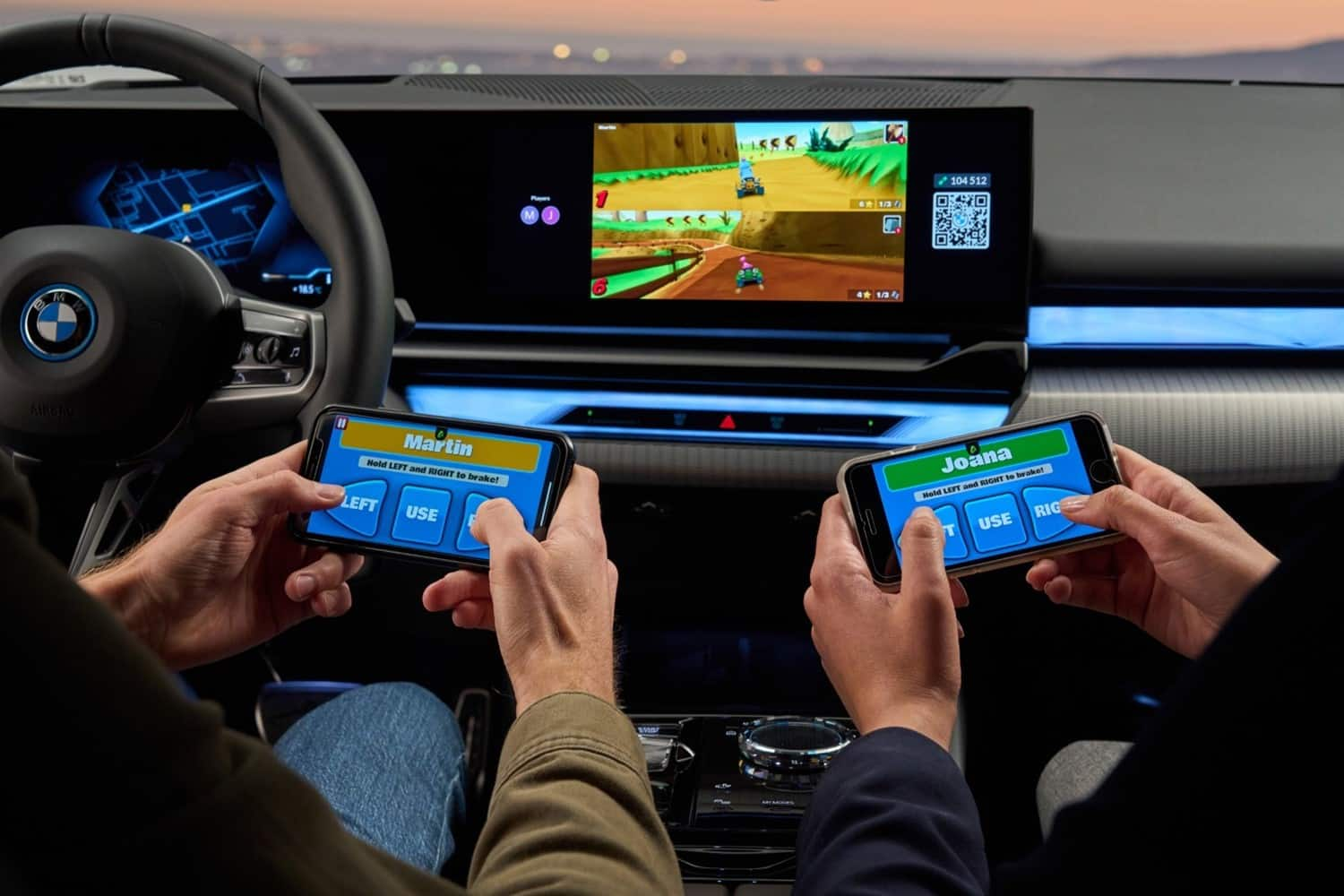
AirConsole in-car gaming in the 2024 BMW 5
Series
Source: BMW
In-car gaming market trends
In-car gaming platforms and consoles are being actively
showcased by original equipment manufacturers and suppliers alike.
CES 2023 in Las Vegas was filled with examples of car-related
gaming products and services. A quick review of the unveilings:
- The Sony-Honda joint venture Sony Honda Mobility revealed the
Afeela EV prototype, which will incorporate technology from Epic
Games’ Unreal Engine. The company’s Unreal Engine 3D tool was also
featured in Volvo’s battery-electric EX90 SUV. Stellantis
highlighted the Ram 1500 Revolution BEV Concept featuring two
14.2-inch touchscreen displays that can be combined or used
separately as a video game controller. - On the supplier side, NVIDIA revealed its GeForce NOW cloud
gaming service, with Hyundai, BYD and Polestar working with the
company to integrate the same. The GeForce NOW client for
automotive can run on Android- or browser-based in-vehicle
infotainment systems, including an app to easily select and launch
games. - Visteon showed its fourth generation SmartCore cockpit domain
controller that supports multi-display entertainment and gaming,
and Garmin demonstrated its ‘Unified Cabin’ concept with an
emphasis on technologies that unify multiple domains, touchscreens,
and wireless devices on a single system-on-chip (SoC) – with
wireless gaming controllers from Atari. - ThunderSoft revealed the E-Cockpit 7.0, its seventh-generation
cockpit product, with upgraded computing power and enriched user
experience for applications such as immersive cockpit games.
Teraflops and gigabytes
Tesla has a team of software engineers in Seattle working on
video games, and more recently started building a similar team in
Austin. The company added an Atari video game emulator using an
over-the-air (OTA) software update back in 2018, followed by the
launch of the ‘Tesla Arcade’ in-car gaming platform in 2019. One of
the first successful implementations of gaming built into a car,
the user interface allowed users to play games through the car
itself rather than using a third-party handheld console. Tesla’s
racing game, “Beach Buggy Racing 2,” allowed the on-screen action
to be controlled with the car’s steering wheel and pedals.
In 2021, Tesla equipped its Model S and Model X vehicles with an
AMD APU processor and a discrete RDNA2 GPU for graphics, resulting
in up to 10 teraflops of computing power, with Elon Musk comparing
its capabilities to Sony’s PlayStation 5. The following year the
cars were integrated with Valve’s Steam, an online video game store
and distribution platform. With 16 gigabytes of RAM available,
Steam integration means users of the 2022 or newer Model S or Model
X have access to thousands of games.
At the 2019 Mobile World Congress, Mercedes-Benz demonstrated a
CLA coupe featuring SuperTuxKart — an open-source variant of a
classic Nintendo game — which was playable on the large
Mercedes-Benz User Experience (MBUX) infotainment system screen.
Ambient lighting and interior airflow changed according to the game
environment. Thanks to a collaborative deal between Mercedes-Benz
and Faurecia in 2022, the latter’s Aptoide automotive app store
will bring Rovio Entertainment’s popular slingshot game Angry Birds
to the new 2024 E-Class’ MBUX Hyperscreen infotainment system.
Audi’s move into in-car gaming started in 2019 when it spun out
Holoride, a startup that combines Extended Reality (XR)
technologies with real-time vehicle data, resulting in a virtual
space where riders can enjoy interactive and passive content that
reacts to both them and the motion of the car. Holoride technology
is based on HTC’s Vive Virtual Reality (VR) platform and works with
the Vive Flow headset, which wirelessly connects with a vehicle’s
infotainment hardware. Select Audi models featuring the
third-generation modular infotainment toolkit (MIB 3) and the
latest software cluster offer Holoride-capability for rear seat
passengers.
Holoride’s aftermarket retrofit device, which can render any
vehicle game-ready, provided the user has a subscription to the
Holoride platform, was launched for $199 at CES 2023. The basic
subscription costs $20 a month or $180 yearly. A $799 package
includes the retrofit hardware, an HTC Vive Flow headset, a
one-year Holoride subscription and a safety strap. Currently,
Holoride users can only play “Cloudbreakers: Leaving Haven” from
Schell Games, the studio that brought “Among Us” to VR.
BMW announced a partnership with gaming platform AirConsole in
October 2022 and launched the new 5 Series with the AirConsole app
in May 2023. Drivers or passengers will be able to play games while
the vehicle is stationary. All they need is their smartphone, which
will act as a controller, and the BMW Curved Display. The
connection between the smartphone and the vehicle is intuitively
established by scanning a QR code on the Curved Display, and the
AirConsole app supports multiple players. AirConsole will be
available on the 7 Series and X5 and larger SUVs, as well the iX
and i4 models, by September this year.
Lexus unveiled in 2021 the Gamers’ IS vehicle designed by the
Twitch community in which LED panels projected content onto the
rear window. The car featured a custom-built gaming PC installed in
the vehicle’s trunk. The gaming system on the passenger’s side had
haptic feedback in the seat and a high-definition curved monitor,
along with a retractable keyboard and mouse platform, and a
3D-printed game controller.
Mainland China’s BYD has received a graphical user interface
(GUI) patent, which can be used to connect the steering wheel or
controller with in-car games based on the vehicle system. It is
also working with NVIDIA to bring GeForce NOW cloud game streaming
to its vehicles.
In-car gaming revenue dynamics
The in-car gaming market is creating exciting collaboration
possibilities between automakers, game content developers, software
companies, AR and VR players, and chip companies, among others.
Automakers typically partner with a gaming distribution platform
to make some or all of their content library available in their
vehicles. For example, Tesla has a deal with Steam to make Steam
Deck games available within Tesla Arcade. Either the games are free
to use (like AirConsole games inside BMWs) or users need to log
into their existing Steam or GeForce NOW accounts to play games
they have already purchased.
AirConsole’s parent company N-Dream has a subscription revenue
share model for developers to create games exclusively for
AirConsole. While BMW pays N-Dream a recurring fee to offer
AirConsole games in its cars, AirConsole remits some of this back
to its developers.
Looking to the future, while automakers are currently looking to
use in-car gaming to differentiate themselves via third-party
licensing deals, they will eventually have to produce exclusive
native content for the strategy to work effectively.
SUBSCRIBE TO THE TOP 10 INDUSTRY
TRENDS NEWSLETTER
CONNECTED-CAR SERVICES CONSUMERS
ARE WILLING TO PAY FOR
FOR MORE COMPONENT FORECAST
ANALYSIS
AUTOMOTIVE FEATURES AND TECHNOLOGY
BENCHMARKING
HOW EV PLATFORMS AND TECHNOLOGY
COULD TRANSFORM AUTO INTERIOR DESIGN
PREMIUM AUDIO ENTERS THE MASS
MARKET
This article was published by S&P Global Mobility and not by S&P Global Ratings, which is a separately managed division of S&P Global.
- SEO Powered Content & PR Distribution. Get Amplified Today.
- PlatoData.Network Vertical Generative Ai. Empower Yourself. Access Here.
- PlatoAiStream. Web3 Intelligence. Knowledge Amplified. Access Here.
- PlatoESG. Automotive / EVs, Carbon, CleanTech, Energy, Environment, Solar, Waste Management. Access Here.
- BlockOffsets. Modernizing Environmental Offset Ownership. Access Here.
- Source: http://www.spglobal.com/mobility/en/research-analysis/incar-gaming-key-players-developments-and-outlook.html
- :has
- :is
- :not
- :where
- ][p
- $UP
- 10
- 14
- 16
- 2018
- 2019
- 2021
- 2022
- 2023
- 2024
- 2026
- 3d
- 5G
- 5G networks
- 7
- a
- Able
- About
- abruptly
- access
- According
- Accounts
- achieved
- Act
- Action
- Activation
- actively
- added
- Additionally
- AIR
- Aligns
- alike
- All
- allow
- allowed
- Allowing
- along
- already
- also
- Ambient
- AMD
- among
- among us
- an
- and
- announced
- answer
- any
- anywhere
- app
- app store
- applications
- appropriate
- AR
- Arcade
- ARE
- AREA
- article
- AS
- At
- atari
- attraction
- audi
- audio
- austin
- auto
- automakers
- Automated
- automotive
- available
- away
- back
- based
- basic
- BE
- Beach
- becoming
- been
- Beginning
- being
- bespoke
- between
- Billion
- Birds
- BMW
- both
- bring
- broader
- brought
- Building
- built
- burning
- business
- but
- by
- byd
- CAN
- capabilities
- car
- cars
- Ces
- changed
- China
- chip
- classic
- clearly
- client
- Cloud
- Cluster
- Cockpit
- code
- cold
- collaboration
- collaborative
- combined
- combines
- community
- Companies
- company
- comparing
- compatible
- component
- computing
- computing power
- concept
- Congress
- Connect
- connection
- Connectivity
- connects
- Console
- consoles
- Consumers
- content
- controlled
- controller
- Core
- Costs
- could
- create
- Creating
- Cross
- Currently
- Custom-built
- data
- deal
- Deals
- demonstrated
- designed
- developers
- developments
- device
- Devices
- differentiate
- digital
- Display
- displays
- distribution
- Division
- domain
- domains
- driver
- drivers
- drives
- driving
- easily
- effectively
- effects
- either
- Elon
- Elon Musk
- emphasis
- Engine
- Engineers
- Engines
- enjoy
- enriched
- Enters
- Entertainment
- Environment
- EPIC
- equipment
- equipped
- established
- Ether (ETH)
- EV
- eventually
- everyone
- example
- examples
- exciting
- Exclusive
- exclusively
- existing
- expensive
- experience
- Experiences
- explosion
- extended reality
- featured
- Features
- Featuring
- fee
- feedback
- filled
- First
- flow
- Focus
- followed
- following
- For
- Forecast
- Fourth
- Free
- fresh
- from
- front
- future
- game
- game store
- Gamers
- Games
- gaming
- Gaming industry
- gaming market
- gaming pc
- gaming platform
- Garmin
- generating
- generation
- Global
- going
- GPU
- GPUs
- graphics
- grass
- Growth
- had
- haptic
- Hard
- Hardware
- Have
- Headset
- high-caliber
- high-definition
- high-quality
- Highlighted
- highly
- Holoride
- Home
- However
- HTC
- htc vive
- HTC Vive Flow
- HTML
- HTTPS
- huge
- Hyundai
- ideal
- if
- immersive
- Impact
- in
- includes
- Including
- incorporate
- industry
- inside
- installed
- instance
- integrate
- integrated
- integration
- interactive
- Interface
- interior
- into
- IT
- ITS
- itself
- joint
- joint venture
- jpg
- Key
- large
- larger
- LAS
- Las Vegas
- latest
- launch
- launched
- leaving
- Led
- Level
- Library
- Licensing
- Lighting
- like
- log
- long-term
- Look
- look like
- looking
- Lot
- lucrative
- made
- maintain
- make
- managed
- Manufacturers
- many
- Market
- mask
- Mass
- May..
- meaningful
- means
- might
- Mobile
- Mobile World Congress
- mobility
- model
- models
- Modern
- modular
- money
- Monitor
- Month
- more
- most
- mostly
- motion
- move
- multiple
- Musk
- nascent
- native
- Need
- networks
- New
- newer
- next-generation
- Nintendo
- now
- Nvidia
- october
- of
- offer
- on
- ONE
- online
- online video
- only
- onto
- open source
- Opportunity
- or
- original
- Others
- out
- Outlook
- package
- packages
- panels
- parent company
- part
- partner
- Partnership
- passive
- patent
- Pay
- pays
- PC
- physical
- platform
- Platforms
- plato
- Plato Data Intelligence
- PlatoData
- Play
- played
- players
- playstation
- PlayStation 5
- poised
- Popular
- possibilities
- possible
- potential
- power
- powerful
- processing
- Processor
- produce
- Product
- Products
- Products and Services
- projected
- proof
- prototype
- provided
- published
- purchased
- QR code
- Quick
- racing
- RAM
- rapid
- rather
- ratings
- reach
- Reacts
- real-time
- Reality
- received
- recent
- recently
- recurring
- remain
- rendering
- report
- resulting
- Revealed
- revenue
- review
- Revolution
- riders
- road
- rubber
- Run
- s
- S&P
- S&P Global
- Safety
- same
- scanning
- schell
- Schell Games
- Screen
- screens
- Seattle
- separately
- September
- Series
- service
- Services
- Share
- shared
- shared mobility
- Short
- showcased
- showed
- side
- similar
- since
- single
- smartphone
- Smell
- So
- Social
- Social impact
- Software
- software update
- some
- something
- Sony
- Space
- spun
- Star
- Stars
- started
- startup
- Steam
- steering
- steering wheel
- Still
- store
- stores
- Strategy
- stream
- streaming
- streams
- studio
- subscription
- successful
- such
- sudden
- Suggests
- supplier
- suppliers
- Supports
- SUVs
- system
- Systems
- team
- Technologies
- Technology
- term
- Tesla
- than
- thanks
- that
- The
- The Future
- their
- Them
- themselves
- then
- There.
- These
- they
- third-party
- this
- this year
- thousands
- Through
- tighten
- to
- tool
- toolkit
- top
- Top 10
- Touchscreen
- Touchscreens
- towards
- track
- Transform
- Trend
- Trends
- Twice
- Twitch
- two
- typically
- unified
- units
- Unreal
- Unreal Engine
- unveiled
- Update
- upgraded
- us
- use
- used
- User
- User Experience
- User Interface
- users
- using
- valve
- Variant
- VEGAS
- vehicle
- Vehicles
- venture
- via
- Video
- video game
- video games
- Virtual
- Virtual reality
- virtually
- vive
- Vive flow
- volvo
- vr
- Wall
- warm
- was
- WELL
- were
- What
- What is
- Wheel
- when
- which
- while
- will
- willing
- window
- wireless
- with
- within
- without
- Work
- working
- works
- world
- worldwide
- X
- XR
- year
- yearly
- years
- yes
- zephyrnet



